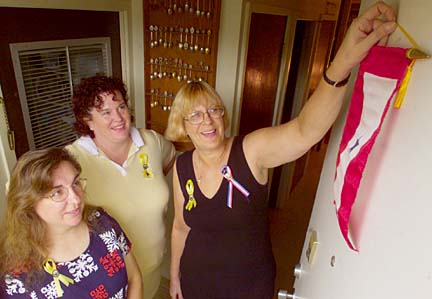
DEAN SENSUI / DSENSUI@STARBULLETIN.COM
Therese Lester and Michelle Cloud watched Carol Lester hang a blue star service banner on Friday on the front door of her home in Navy housing. Carol Lester’s husband, Cmdr. Edward Lester, is the skipper of the USS Reuben James, currently fighting in the war on Iraq. The banners feature dark blue stars representing each family member serving in the armed forces.
In 1944, a mother of four servicemen fighting on battlefields in Europe and in the Pacific hung a banner embossed with four blue stars, one for each son, in her Iowa kitchen window. Banner of pride
Service families show their support
for loved ones sent abroad through a
tradition started in World War IBy Gregg K. Kakesako
gkakesako@starbulletin.comThat scene from the Steven Spielberg movie "Saving Private Ryan," starring Tom Hanks, was part of the reason Therese Lester, a Navy wife for 17 years, decided to get as many of these blue star service banners hung in as many windows and homes in Hawaii.
"Military wives are quiet soldiers," said Lester, whose husband, Cmdr. Edward Lester, is skipper of the frigate USS Reuben James, fighting in the Iraq conflict. "This is a way they can have visual pride in their country and their spouses. They can honor their spouses by displaying this flag in their window."
During World War I and World War II, the blue star banner, a simple white rectangle banner with large red borders, was hung by families who had a loved one in combat. A dark blue star represented each family member serving in the armed forces.
When the service member was killed, a gold star replaced the blue.
Since 1936, the president has declared the last Sunday in September as "Gold Star Mother's Day." When World War II ended, there were as many as 22,000 women who belonged to the American Gold Star Mother organization.
The U.S. House passed a resolution last week encouraging service families to hang these banners.
The banner's popularity faded during the Korean and Vietnam wars. A few were seen during the 1991 Persian Gulf conflict. However, the American Legion wants to bring them back.
Therese Lester said her husband was in the process of taking command of the Pearl Harbor-based Reuben James shortly after the Sept. 11, 2001, terrorist attacks when he saw an article in U.S. Naval Academy's alumni magazine suggesting that these banners be again be displayed.
Since then, Therese Lester said that whenever she meets with Navy families, she always has a small brown shopping bag that has information on the blue star banner and how it can be obtained through the American Legion.
"It's a matter of pride," said Michelle Cloud, whose husband, Petty Officer Palae Cloud, is the Reuben James' postal clerk.
"I am so proud to have that in my window ... knowing what he is doing, fighting for people who can't fight for themselves."
An American Legion fact sheet says the blue star service banner was designed and patented in 1917 by World War I Army Capt. Robert Queissner of the 5th Ohio Infantry, who had two sons serving in combat.
In World War II, the U.S. Department of War drafted guidelines covering the manufacture of the banner and when and by whom the service banner could be displayed or a service lapel pin could be worn.
During the war with Iraq, blue star banners can be displayed by families who have a son, daughter, brother, sister, wife, husband, cousin or grandchild in the Middle East. Included in that group are members of the National Guard and the Reserves who were activated.
Carol Laycock, whose husband, Chief Petty Officer Carl Laycock, is a firefighter on the Reuben James, has gotten one for her mother who lives in North Charleston, S.C.
"I am just proud of what my husband is doing," said Laycock, who is anxiously looking forward to when she can finally take it down, since the Reuben James has been on an extended nine-month deployment with the USS Abraham Lincoln carrier battle group.
It was on New Year's Day that the Lincoln's orders to return home after a normal six-month deployment were rescinded and the carrier and its flotilla of war ships, including the Reuben James and the destroyer USS Paul Hamilton from Pearl Harbor, were sent to the Persian Gulf.
"They have been at sea continuously now for 240 days," said Therese Lester.
"Every day he (Ed Lester) sends e-mails to family members where he talks about the morale and the level of patriotism the men have," she added, "and that it is unwavering. There are no fluctuations on whether we need to be there."
Cloud said she believes this Iraqi war is "a lot more intense" than the conflict more than a decade ago when her husband served on another frigate, the USS Elmer Montgomery, in the Red Sea.
Cloud said the only news the 240 sailors on the 455-foot Reuben James gets is from CNN by satellite, and the sight of the protesters bothers her husband.
"That is why things like these banners and the yellow ribbons are really good," Cloud said. "It really shows them that we are very appreciative of what they are doing."
The Blue Star Banner can be purchased through the American Legion office here by calling 946-6383. The banners can also be ordered through the American Legion's Web site at www.legion.org.
